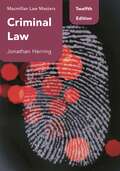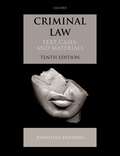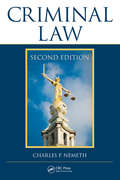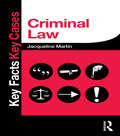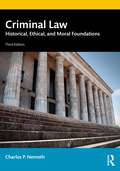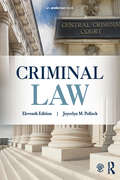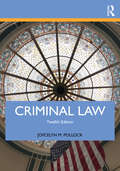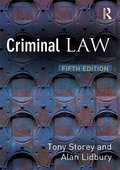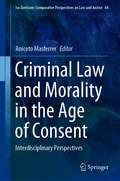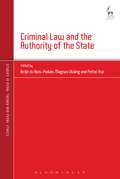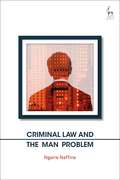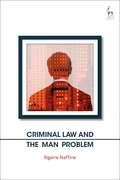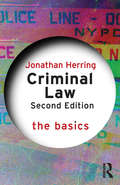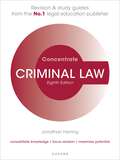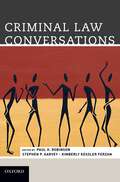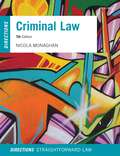- Table View
- List View
Criminal Law (Macmillan Law Masters)
by Jonathan HerringThis bestselling, classic textbook provides a clear and straightforward account of criminal law, while also introducing current debates about the nature, scope and functions of the law and discussing wider controversies surrounding the basic doctrines. Written by one of the UK's leading experts on criminal law, this book is compact yet comprehensive, well-structured, stimulating and engaging.
Criminal Law: Text, Cases, and Materials (Text, Cases, and Materials)
by Jonathan HerringCriminal Law: Text, Cases, and Materials offers comprehensive legal coverage and insightful analysis alongside expertly selected extracts from key cases and academic sources. The effective two-part structure of each chapter in the book - the first part explaining the law as it is, the second examining the theoretical aspects of the law - ensures that readers not only gain a secure understanding of the law itself but also acquire a fundamental appreciation of the surrounding philosophical and ethical debates. Important theoretical material is made accessible to students through a particularly engaging writing style. The author's clarity of expression brings the subject to life and places the law in context. This text is an essential and complete resource for all those wanting to get to grips with the fascinating and sometimes challenging area of criminal law. Digital formats and resources This edition is available for students and institutions to purchase in a variety of formats, and is supported by online resources. The e-book offers a mobile experience and convenient access along with functionality tools, navigation features, and links that offer extra learning support: www.oxfordtextbooks.co.uk/ebooks The text is also supported by online resources, including: - Self-test questions - An introductory video from the author talking about the study of criminal law and his approach to the subject - Key case flashcards - Guidance on answering selected questions in the book - Bibliography - Useful web links
Criminal Law (Hart Law Masters)
by Jonathan HerringWritten by one of the leading experts in the field, Criminal Law is the ideal companion for undergraduate and postgraduate students looking for an accessible, engaging and concise introduction to criminal law. Covering the basic principles of criminal liability, it specifically highlights the criminal offences which not only best illustrate the underlying criminal law principles, but also feature most heavily on substantive criminal law modules. In this new 13th edition, violence against women has been highlighted as a key theme, covering changes to the Domestic Violence Act 2021 and interesting developments in the “rough sex defence”; defences to criminal damage, causation, and the new offence of strangulation and consent in abusive relationships. A perfect combination of underlying theory and contemporary debates and controversies, this text is the one-stop shop for all students determined to excel in their coursework and exams, as well as in legal practice.
Criminal Law: Law Revision And Study Guide (Hart Law Masters)
by Jonathan HerringWritten by one of the leading experts in the field, Criminal Law is the ideal companion for undergraduate and postgraduate students looking for an accessible, engaging and concise introduction to criminal law. Covering the basic principles of criminal liability, it specifically highlights the criminal offences which not only best illustrate the underlying criminal law principles, but also feature most heavily on substantive criminal law modules. In this new 13th edition, violence against women has been highlighted as a key theme, covering changes to the Domestic Violence Act 2021 and interesting developments in the “rough sex defence”; defences to criminal damage, causation, and the new offence of strangulation and consent in abusive relationships. A perfect combination of underlying theory and contemporary debates and controversies, this text is the one-stop shop for all students determined to excel in their coursework and exams, as well as in legal practice.
Criminal Law
by John D. HolmesIn order to fully grasp criminal law concepts, students must go beyond mere rote memorization of the penal code and attempt to understand where the laws originate from and how they have developed. Criminal Law, Second Edition blends legal and moral reasoning in the examination of crimes and explores the history relating to jurisprudence and ro
Criminal Law (Key Facts Key Cases)
by Jacqueline MartinKey Facts Key Cases: Criminal Law will ensure you grasp the main concepts of your Criminal Law module with ease. This book explains the facts and associated case law for: the important concepts of actus reus, mens rea and strict liability the main fatal and non-fatal offences against the person a wide range of property offences general defences the topics of participation and inchoate offences Key Facts Key Cases is the essential series for anyone studying law at LLB, postgraduate and conversion courses. The series provides the simplest and most effective way to absorb and retain all of the material essential for passing your exams. Each chapter includes: diagrams at the start of chapters to summarise key points structured headings and numbered points to allow for clear recall of the essential points charts and tables to break down more complex information Chapters are also supported by a Key Cases section which provides the simplest and most effective way to absorb and memorise essential cases needed for exam success. Essential and leading cases are explained The style, layout and explanations are user friendly Cases are broken down into key components by use of a clear system of symbols for quick and easy visual recognition
Criminal Law (Key Facts Key Cases)
by Jacqueline MartinKey Facts Key Cases: Criminal Law will ensure you grasp the main concepts of your Criminal Law module with ease. This book explains the facts and associated case law for: the important concepts of actus reus, mens rea and strict liability the main fatal and non-fatal offences against the person a wide range of property offences general defences the topics of participation and inchoate offences Key Facts Key Cases is the essential series for anyone studying law at LLB, postgraduate and conversion courses. The series provides the simplest and most effective way to absorb and retain all of the material essential for passing your exams. Each chapter includes: diagrams at the start of chapters to summarise key points structured headings and numbered points to allow for clear recall of the essential points charts and tables to break down more complex information Chapters are also supported by a Key Cases section which provides the simplest and most effective way to absorb and memorise essential cases needed for exam success. Essential and leading cases are explained The style, layout and explanations are user friendly Cases are broken down into key components by use of a clear system of symbols for quick and easy visual recognition
Criminal Law: Historical, Ethical, and Moral Foundations
by Charles P. NemethCriminal Law: Historical, Ethical, and Moral Foundations, 3rd edition, blends legal and moral reasoning in the examination of crimes and explores the history relating to jurisprudence and roots of criminal law. In order to fully grasp criminal law concepts, students must go beyond mere rote memorization of the penal code and endeavor to understand where the laws originate from and how they have developed. This book fosters discussions of controversial issues and delivers abridged case law decisions that target the essence of appellate rulings. Grounded in the Model Penal Code, making the text national in scope, this volume examines: Why the criminal codes originated, and the moral, religious, spiritual, and human influences that led to our present system How crimes are described in the modern criminal justice model The two essential elements necessary for criminal culpability: actus reus (the act committed or omitted) and mens rea (the mind and intent of the actor) Offenses against the body resulting in death, including murder, manslaughter, felony murder, and negligent homicide Non-terminal criminal conduct against the body, including robbery, kidnapping, false imprisonment, assault, and hate crimes Sexual assault, rape, necrophilia, incest, and child molestation Property offenses, such as larceny/theft, bribery, forgery, and embezzlement Crimes against the home, including burglary, trespassing, arson, and vandalism The book also examines controversial public morality issues such as prostitution, drug legalization, obscenity, and pornography. The final two chapters discuss inchoate offenses, where the criminal act has not been completed, and various criminal defenses, such as legal insanity, entrapment, coercion, self-defense, and mistake of fact or law. Important keywords introduce each chapter, and discussion questions and suggested readings appear at the end of each chapter, prompting lively debate and further inquiry into a fascinating subject area that continues to evolve. Updated to include the latest developments in the law, this book is appropriate for undergraduate students in criminal law and related courses.
Criminal Law: Historical, Ethical, and Moral Foundations
by Charles P. NemethCriminal Law: Historical, Ethical, and Moral Foundations, 3rd edition, blends legal and moral reasoning in the examination of crimes and explores the history relating to jurisprudence and roots of criminal law. In order to fully grasp criminal law concepts, students must go beyond mere rote memorization of the penal code and endeavor to understand where the laws originate from and how they have developed. This book fosters discussions of controversial issues and delivers abridged case law decisions that target the essence of appellate rulings. Grounded in the Model Penal Code, making the text national in scope, this volume examines: Why the criminal codes originated, and the moral, religious, spiritual, and human influences that led to our present system How crimes are described in the modern criminal justice model The two essential elements necessary for criminal culpability: actus reus (the act committed or omitted) and mens rea (the mind and intent of the actor) Offenses against the body resulting in death, including murder, manslaughter, felony murder, and negligent homicide Non-terminal criminal conduct against the body, including robbery, kidnapping, false imprisonment, assault, and hate crimes Sexual assault, rape, necrophilia, incest, and child molestation Property offenses, such as larceny/theft, bribery, forgery, and embezzlement Crimes against the home, including burglary, trespassing, arson, and vandalism The book also examines controversial public morality issues such as prostitution, drug legalization, obscenity, and pornography. The final two chapters discuss inchoate offenses, where the criminal act has not been completed, and various criminal defenses, such as legal insanity, entrapment, coercion, self-defense, and mistake of fact or law. Important keywords introduce each chapter, and discussion questions and suggested readings appear at the end of each chapter, prompting lively debate and further inquiry into a fascinating subject area that continues to evolve. Updated to include the latest developments in the law, this book is appropriate for undergraduate students in criminal law and related courses.
Criminal Law
by Joycelyn M. PollockCriminal Law, Eleventh Edition, a classic introduction to criminal law for criminal justice students, combines the best features of a casebook and a textbook. Its success over numerous editions, both at community colleges as well as in four-year college criminal justice programs, is proof this text works as an authoritative source on criminal law as well as a teaching text that communicates with students. The book covers substantive criminal law and explores its principles, sources, distinctions, and limitations. Definitions and elements of crimes are explained, and defenses to crimes are thoroughly analyzed. Each chapter offers guidance to help students understand what is important, including chapter outlines, key terms, learning objectives, Legal News boxes that highlight current criminal law issues, and Quick Checks that cue the reader to stop and answer a question or two concerning the material just covered. Unique Exploring Case Law boxes offer guidance in using the accompanying cases, which are provided on the book’s website. A robust collection of instructor support materials addresses teaching and learning issues
Criminal Law
by Joycelyn M. PollockCriminal Law, Eleventh Edition, a classic introduction to criminal law for criminal justice students, combines the best features of a casebook and a textbook. Its success over numerous editions, both at community colleges as well as in four-year college criminal justice programs, is proof this text works as an authoritative source on criminal law as well as a teaching text that communicates with students. The book covers substantive criminal law and explores its principles, sources, distinctions, and limitations. Definitions and elements of crimes are explained, and defenses to crimes are thoroughly analyzed. Each chapter offers guidance to help students understand what is important, including chapter outlines, key terms, learning objectives, Legal News boxes that highlight current criminal law issues, and Quick Checks that cue the reader to stop and answer a question or two concerning the material just covered. Unique Exploring Case Law boxes offer guidance in using the accompanying cases, which are provided on the book’s website. A robust collection of instructor support materials addresses teaching and learning issues
Criminal Law
by Joycelyn M. PollockCriminal Law, Twelfth Edition, a classic introduction to criminal law for criminal justice students, combines the best features of a casebook and a textbook. Its success over numerous editions, both at community colleges as well as in four-year college criminal justice programs, is proof this text works as an authoritative source on criminal law, as well as a teaching text that communicates with students. The book covers substantive criminal law and explores its principles, sources, distinctions, and limitations. Definitions and elements of crimes are explained, and defenses to crimes are thoroughly analyzed. Each chapter offers guidance to help students understand what is important, including chapter outlines, key terms, learning objectives, Legal News boxes that highlight current criminal law issues, and Quick Checks that cue the reader to stop and answer a question or two concerning the material just covered. Unique Exploring Case Law boxes offer guidance in using the accompanying cases, which are provided on the book’s website and in Part II of this textbook. A robust collection of instructor support materials addresses teaching and learning issues. Updated with all the newest relevant law, this book is appropriate for undergraduate students in criminal law and related courses.
Criminal Law
by Joycelyn M. PollockCriminal Law, Twelfth Edition, a classic introduction to criminal law for criminal justice students, combines the best features of a casebook and a textbook. Its success over numerous editions, both at community colleges as well as in four-year college criminal justice programs, is proof this text works as an authoritative source on criminal law, as well as a teaching text that communicates with students. The book covers substantive criminal law and explores its principles, sources, distinctions, and limitations. Definitions and elements of crimes are explained, and defenses to crimes are thoroughly analyzed. Each chapter offers guidance to help students understand what is important, including chapter outlines, key terms, learning objectives, Legal News boxes that highlight current criminal law issues, and Quick Checks that cue the reader to stop and answer a question or two concerning the material just covered. Unique Exploring Case Law boxes offer guidance in using the accompanying cases, which are provided on the book’s website and in Part II of this textbook. A robust collection of instructor support materials addresses teaching and learning issues. Updated with all the newest relevant law, this book is appropriate for undergraduate students in criminal law and related courses.
Criminal Law
by Tony Storey Alan LidburyThis textbook covers the Criminal Law option of the A-level law syllabus, and provides an ideal introduction for anybody coming to the subject for the first time. Criminal Law covers all A-level syllabuses/specification requirements, and is written by the principal examiner and principal assistant examiner in Criminal Law for one of the major examination boards. It contains extensive case illustration, and a range of examination related questions and activities. There is a special focus on key skills, and on the new synoptic assessment syllabus requirements. This fully updated third edition builds upon the success of the first two editions. It: provides coverage of OCR and AQA specifications is endorsed by OCR for use with the Criminal Law option includes new OCR synoptic assessment source materials (for use in examinations in June 2005) with additional guidance discusses new legislation and cases including Sexual Offences Act 2003, Andrews, Bollom, G and R, Rowland, Safi and others, Weller, Z.
Criminal Law
by Tony Storey Alan LidburyThis textbook covers the Criminal Law option of the A-level law syllabus, and provides an ideal introduction for anybody coming to the subject for the first time. Criminal Law covers all A-level syllabuses/specification requirements, and is written by the principal examiner and principal assistant examiner in Criminal Law for one of the major examination boards. It contains extensive case illustration, and a range of examination related questions and activities. There is a special focus on key skills, and on the new synoptic assessment syllabus requirements. This fully updated third edition builds upon the success of the first two editions. It: provides coverage of OCR and AQA specifications is endorsed by OCR for use with the Criminal Law option includes new OCR synoptic assessment source materials (for use in examinations in June 2005) with additional guidance discusses new legislation and cases including Sexual Offences Act 2003, Andrews, Bollom, G and R, Rowland, Safi and others, Weller, Z.
Criminal Law and Morality in the Age of Consent: Interdisciplinary Perspectives (Ius Gentium: Comparative Perspectives on Law and Justice #84)
by Aniceto MasferrerThis book discusses the relation between morality and politics, and morality and law, a field that has been studied for more than two thousand years The law is a part of human culture, and this touches upon a dynamic reality that is connected to the relation between nature and freedom, nature and culture. If such relations are not clearly understood, as is the case today, the relation between morality and law cannot be properly comprehended either. The relationship between morality and criminal law must constantly evolve to meet the needs of changing times and circumstances. Social changes and new situations require new answers. And since the relationship involves criminal law, legal philosophy and legal history, interdisciplinary approaches are always needed. Featuring fifteen original contributions by legal scholars from various European and American universities, the book does not pretend to solve the complexity of the relation between morality and criminal law, but instead expresses criticism, offers some proposals and stimulates further thought. The book tackles the topic from an interdisciplinary perspective (criminal law, constitutional law, legal philosophy and legal history, among others). As such, it appeals not only to scholars and students, but also to lawyers, policymakers, historians, theologians, philosophers and general readers who are interested in the legal, social, political and philosophical issues of our time.
Criminal Law and the Authority of the State (Studies in Penal Theory and Penal Ethics)
by Antje du Bois-Pedain Magnus Ulväng Petter AspHow does the state, as a public authority, relate to those under its jurisdiction through the criminal law? Connecting the ways in which criminal lawyers, legal theorists, public lawyers and criminologists address questions of the criminal law's legitimacy, contributors to this collection explore issues such as criminal law-making and jurisdiction; the political-ethical underpinnings of legitimate criminal law enforcement; the offence of treason; the importance of doctrinal guidance in the application of criminal law; the interface between tort and crime; and the purposes and mechanisms of state punishment. Overall, the collection aims to enhance and deepen our understanding of criminal law by conceiving of the practices of criminal justice as explicitly and distinctly embedded in the project of liberal self-governance.
Criminal Law and the Authority of the State (Studies in Penal Theory and Penal Ethics #6)
by Antje du Bois-Pedain Magnus Ulväng Petter AspHow does the state, as a public authority, relate to those under its jurisdiction through the criminal law? Connecting the ways in which criminal lawyers, legal theorists, public lawyers and criminologists address questions of the criminal law's legitimacy, contributors to this collection explore issues such as criminal law-making and jurisdiction; the political-ethical underpinnings of legitimate criminal law enforcement; the offence of treason; the importance of doctrinal guidance in the application of criminal law; the interface between tort and crime; and the purposes and mechanisms of state punishment. Overall, the collection aims to enhance and deepen our understanding of criminal law by conceiving of the practices of criminal justice as explicitly and distinctly embedded in the project of liberal self-governance.
Criminal Law and the Man Problem
by Ngaire NaffineMen have always dominated the most basic precepts of the criminal legal world – its norms, its priorities and its character. Men have been the regulators and the regulated: the main subjects and objects of criminal law and by far the more dangerous sex. And yet men, as men, are still hardly talked about as the determining force within criminal law or in its exegesis. This book brings men into sharp focus, as the pervasively powerful interest group, whose wants and preoccupations have shaped the discipline. This constitutes the 'man problem' of criminal law.This new analysis probes the unacknowledged thinking of generations of influential legal men, which includes the psychological and legal techniques that have obscured the operation of bias, even to the legal experts themselves. It explains how men's interests have influenced the most cherished legal norms, especially the rules of human contact, which were designed to protect men from other men, while specifically securing lawful sexual access to at least one woman. The aim is to test the discipline's broadest commitments to civility, and its trajectory towards the final resolution, when men and women were declared to be equal and equivalent legal persons. In the process it exposes the morally and intellectually limiting consequences of male power.
Criminal Law and the Man Problem
by Ngaire NaffineMen have always dominated the most basic precepts of the criminal legal world – its norms, its priorities and its character. Men have been the regulators and the regulated: the main subjects and objects of criminal law and by far the more dangerous sex. And yet men, as men, are still hardly talked about as the determining force within criminal law or in its exegesis. This book brings men into sharp focus, as the pervasively powerful interest group, whose wants and preoccupations have shaped the discipline. This constitutes the 'man problem' of criminal law.This new analysis probes the unacknowledged thinking of generations of influential legal men, which includes the psychological and legal techniques that have obscured the operation of bias, even to the legal experts themselves. It explains how men's interests have influenced the most cherished legal norms, especially the rules of human contact, which were designed to protect men from other men, while specifically securing lawful sexual access to at least one woman. The aim is to test the discipline's broadest commitments to civility, and its trajectory towards the final resolution, when men and women were declared to be equal and equivalent legal persons. In the process it exposes the morally and intellectually limiting consequences of male power.
Criminal Law: The Basics (The Basics)
by Jonathan HerringCriminal Law: The Basics is an insightful introduction to the legal aspects of criminal acts, ranging from battery to burglary and harassment to homicide. Starting with an in-depth exploration of the very concept of crime, the book considers key questions such as: • How should we decide what is criminal and what isn’t? • What is the difference between murder and manslaughter? • Could you ever be guilty of stealing your own property? • What defences are available to those accused of crime? Featuring a range of case studies, from the infamous to the bizarre, the new edition has been thoroughly updated to include new material on loss of control, accessorial liability, dishonesty, causation, liability, manslaughter and sexual offences. Relevant cases, statutes and suggestions for further reading are included throughout, making Criminal Law: The Basics the ideal starting point for anyone studying this area for the first time.
Criminal Law Concentrate (PDF): Law Revision and Study Guide
by Jonathan Herringriminal Law Concentrate is written and designed to help you succeed. Written by experts and covering all key topics, Concentrate guides go above and beyond, not only consolidating your learning but focusing your revision and maximising your exam performance. Each guide includes revision tips, advice on how to achieve extra marks, and a thorough and focused breakdown of the key topics and cases.
Criminal Law Conversations
by Paul H. Robinson Stephen Garvey Kimberly Kessler FerzanCriminal Law Conversations provides an authoritative overview of contemporary criminal law debates in the United States. This collection of high caliber scholarly papers was assembled using an innovative and interactive method of nominations and commentary by the nation's top legal scholars. Virtually every leading scholar in the field has participated, resulting in a volume of interest to those both in and outside of the community. Criminal Law Conversations showcases the most captivating of these essays, and provides insight into the most fundamental and provocative questions of modern criminal law.
Criminal Law - Core Text Series
by Nicola PadfieldCriminal Law provides a concise account of all the relevant aspects of criminal law in a manageable and thought-provoking way. Underpinned by the author's expert insight, this is an essential introductory guide to criminal law. In an area where case law is so integral to effective understanding of the different legal principles, Criminal Law provides numerous key case summaries to help students remember the key points of law, with an authoritativeguiding commentary to help them think critically about and around the subject. Students are able to consolidate their own learning through supporting chapter summaries, further reading, and self-test questions throughout the book.
Criminal Law Directions (Directions)
by Nicola MonaghanDo your students understand the difference between murder and manslaughter? Are they confused by the concept of mens rea and accessorial liability? Criminal Law Directions tackles these and many more questions, introducing students to this exciting area of law. The Directions series has been written with students in mind and are the ideal guide as they approach the subject for the first time. This book will help them: · Gain a complete understanding of the topic: just the right amount of detail conveyed clearly · Understand the law in context: with scene-setting introductions and highlighted case extracts, the practical importance of the law becomes clear · Identify when and how to evaluate the law critically: they'll be introduced to the key areas of debate and given the confidence to question the law · Deepen and test knowledge: visually engaging learning and self-testing features aid understanding and help students tackle assessments with confidence · Elevate their learning: with the ground-work in place you can aspire to take learning to the next level, with direction provided on how to go further Digital formats and resources The seventh edition is available for students and institutions to purchase in a variety of formats, and is supported by online resources. The e-book offers a mobile experience and convenient access along with functionality tools, navigation features and links that offer extra learning support: www.oxfordtextbooks.co.uk/ebooks The online resources that support the book include: · Multiple choice questions · Flashcard glossary · Guidance on answering the end of chapter exam questions . Guidance on answering the end of chapter self-test questions Additional lecturer resources include: · Diagrams from the text · A test bank of further multiple choice questions
